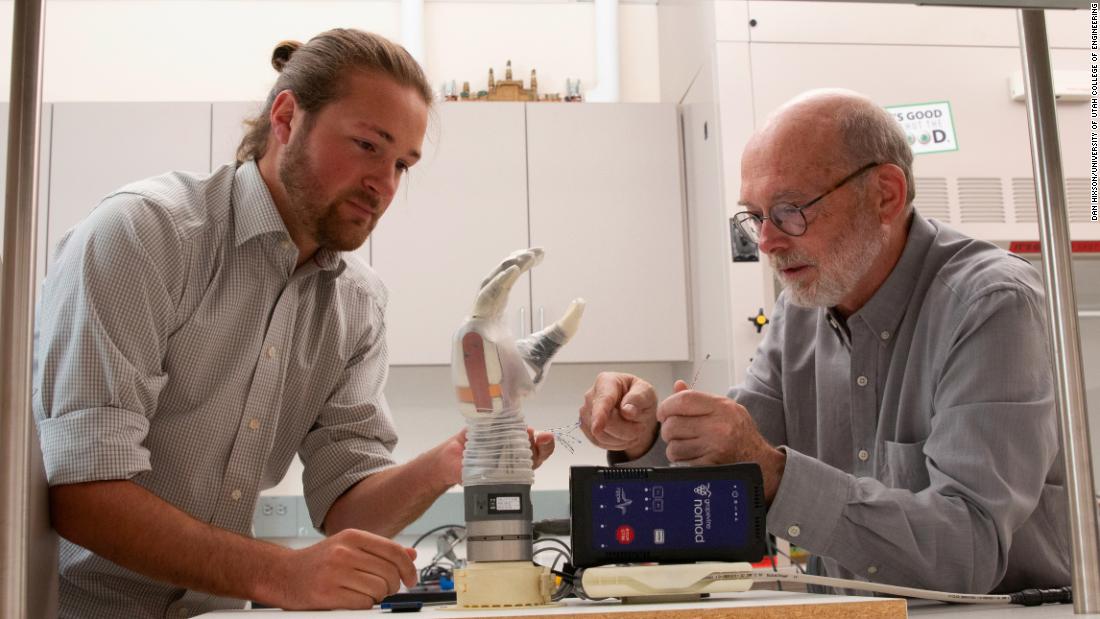[ad_1]
A biomedical engineering team at the University of Utah created the “LUKE Arm,” named in honor of the robotic hand Luke Skywalker obtains in “Star Wars: The Empire Strikes Back” after Darth Vader slices off his hand with a lightsaber.
Previous research has indicated that the ability to feel things is key for amputees. Without that sensation, it’s easy to squeeze too hard and crush an object when trying to pick it up using a prosthetic, especially if metal hooks and claws are being used.
The LUKE Arm sends signals to the brain in order to mimic the way a human hand can feel and sense information about an object, like whether it’s soft, hard, lightweight or heavy.
“We changed the way we are sending that information to the brain so that it matches the human body. And by matching the human body, we were able to see improved benefits,” said Jacob George, study author and biomedical engineering doctoral student at the University of Utah. “We’re making more biologically realistic signals.”
Walgamott is a real estate agent from West Valley City, Utah. He participated in the study as one of seven test subjects.
During different tests using the LUKE Arm, Walgamott was able to handle fragile objects like removing grapes from their stems and pick up an egg without crushing or cracking them. He was even able to hold his wife’s hand and reported having a similar sensation in the fingers of the arm to that of a human hand.
“It almost put me to tears,” Walgamott said after using the LUKE Arm for the first time in 2017. “It was really amazing. I never thought I would be able to feel in that hand again.”
The researchers used modeling and mathematics to make the arm a success. It was in development for 15 years and is composed of metal motors with a clear silicon overlay that mimics skin. The New Hampshire-based DEKA Research and Development Corp., founded by Segway inventor Dean Kamen, created it.
The arm draws power from an external battery and is also wired to a computer.
The university came up with the system that would enable to arm to integrate with the human body so the arm could receive signals. Utah Emeritus Distinguished Professor Richard A. Normann invented the Utah Slanted Electrode Array, a grouping of 100 microelectrodes and wires implanted in the forearm’s nerves and connected to an external computer.
The array was able to read signals from the nerves remaining in Walgamott’s arm while the computer converted them into digital signals. The signals would act like messages for the arm to move.
But in order to be successful, things would have to work the opposite way as well, meaning the LUKE Arm would need to be able to sense objects and understand the necessary pressure needed to hold them.
Sensors in the hand of the LUKE Arm send signals through the Array to the existing nerves, communicating the feeling the hand should be receiving when it touches something.
This mimics the way signals are sent to the brain when a human hand encounters something for the first time, which relies on an impulse burst released from the nerves to the brain.
To recreate this in the LUKE Arm, the researchers recorded impulses as they happened in a primate’s arm. This enabled them to create a model that was integrated into the prosthetic arm system.
“Just providing sensation is a big deal, but the way you send that information is also critically important, and if you make it more biologically realistic, the brain will understand it better and the performance of this sensation will also be better,” said Gregory Clark, study team leader and Utah engineering associate professor.
In the study, the LUKE Arm was also able to help sense other things like temperature and pain.
The next steps include creating a more portable arm that doesn’t require a computer connection, granting the person wireless freedom. They also believe their findings could be applied to people who were amputated above the elbow, since their arm has only been tested on those with amputations below the elbow.
The researchers hope that study participants could take home the arm to use by 2020 or 2021, but federal regulatory approval is pending.
“One of the first things [Walgamott] wanted to do was put on his wedding ring. That’s hard to do with one hand,” says Clark. “It was very moving.”
[ad_2]
Source link







